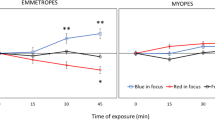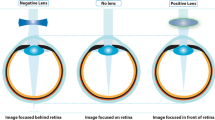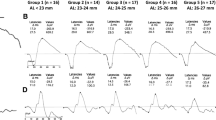Abstract
While retinal defocus is believed to be myopigenic in nature, the underlying mechanism has remained elusive. We recently constructed a theory of refractive error development to investigate its fundamental properties. Our Incremental Retinal-Defocus Theory is based on the principle that the change in retinal-defocus magnitude during an increment of genetically-programmed ocular growth provides the requisite sign for the appropriate alteration in subsequent environmentally-induced ocular growth. This theory was tested under five experimental conditions: lenses, diffusers, occlusion, crystalline lens removal, and prolonged nearwork. Predictions of the theory were consistent with previous animal and human experimental findings. In addition, simulations using a MATLAB/SIMULINK model supported our theory by demonstrating quantitatively the appropriate directional changes in ocular growth rate. Thus, our Incremental Retinal-Defocus Theory provides a simple and logical unifying concept underlying the mechanism for the development of refractive error.
Similar content being viewed by others
References
Abbott, M. L., K. L. Schmid and N. C. Strang (1998). Differences in the accommodation stimulus response curves of adult myopes and emmetropes. Ophthal. Physiol. Opt. 18, 13–20.
Adams, D. W. and N. A. McBrien (1992). Prevalence of myopia and myopic progression in a population of clinical microscopists. Optom. Vis. Sci. 69, 467–473.
Bartmann, M. and F. Schaeffel (1994). A simple mechanism for emmetropization without cues from accommodation or colour. Vision Res. 34, 873–876.
Bennett, A. G. and R. B. Rabbetts (1989). Clinical Visual Optics, Woburn, MA: Butterworth-Heinemann, p. 75.
Bjelke, B. et al. (1996). Dopaminergic transmission in the rat retina: evidence for volume transmission. Chem. Neuroanat. 12, 37–50.
Blackie, C. A. and H. C. Howland (1999). Extension of the Flitcroft model of emmetropization: inclusion of pupil size. Ophthalmic Physiol. Opt. 19, 112–125.
Bradley, D. V., A. Fernandes, M. Tigges and R. G. Boothe (1996). Diffuser contact lenses retard axial elongation in infant rhesus monkeys. Vision Res. 36, 509–514.
Christiansen, A. M. and J. Wallman (1991). Evidence that increased scleral growth underlies visual deprivation myopia in chicks. Invest. Ophthalmol. Vis. Sci. 32, 2134–2150.
Ciuffreda, K. J. (1991). Accommodation and its anomalies, in Vision and Visual Dysfunction: Visual Optics and Instrumentation, Vol. 1, W. N. Charman (Ed.), London: Macmillan, pp. 231–279.
Ciuffreda, K. J. (1998). Accommodation, pupil, and presbyopia, in Borish’s Clinical Refraction, W. J. Benjamin (Ed.), Philadelphia, PA: W. B. Saunders Co, pp. 77–120.
Ciuffreda, K. J. and R. V. Kenyon (1983). Accommodative vergence and accommodation in normals, amblyopes, and strabismics, in Vergence Eye Movements: Basic and Clinical Aspects, C. M. Schor and K. J. Ciuffreda (Eds), Boston, MA: Butterworths, pp. 101–173.
Cohen, A. I. (1981). The retina and the optic nerve, in Adler’s Physiology of the Eye, Clinical Applications, R. A. Moses (Ed.), St. Louis, MO: C. V. Mosby Company, pp. 370–410.
Dowling, J. E. (1996). Retinal processing of vision, in Comprehensive Human Physiology: From Cellular Mechanisms to Integration, Vol. 1, R. Greger and U. Windhorst (Eds), Berlin: Springer-Verlag, pp. 773–778.
Fledelius, H. C. and M. Stubgaard (1986). Changes in refraction and corneal curvature during growth and adult life. A cross-sectional study. Acta Ophthalmol. 64, 487–491.
Flitcroft, D. I. (1998). A model of the contribution of oculomotor and optical factors to emmetropization and myopia. Vision Res. 38, 2869–2879.
Garner, L. F., C. K. Meng, T. P. Grosvenor and N. Mohidin (1990). Ocular dimensions and refractive power in Malay and Melanesian children. Ophthalmic Physiol. Opt. 10, 234–238.
Goss, D. A. and P. Erickson (1987). Meridional corneal components of myopia progression in young adults and children. Am. J. Optom. Physiol. Opt. 64, 475–481.
Goss, D. A. and T. W. Jackson (1993). Cross-sectional study of changes in the ocular components in school children. Appl. Opt. 32, 4169–4173.
Goss, D. A. and M. G. Wickham (1995). Retinal-image mediated ocular growth as a mechanism for juvenile onset myopia and for emmetropization. Doc. Ophthalmol. 90, 341–375.
Goss, D. A. and R. L. Winkler (1983). Progression of myopia in youth: age of cessation. Am. J. Optom. Physiol. Opt. 60, 651–658.
Gottlieb, M. D., H. B. Joshi and D. L. Nickla (1990). Scleral changes in chicks with form-deprived myopia. Curr. Eye Res. 9, 1157–1165.
Grosvenor, T. and D. A. Goss (1998). Role of the cornea in emmetropia and myopia. Optom. Vis. Sci. 75, 132–145.
Grosvenor, T. and D. A. Goss (1999). Etiology of myopia, in Clinical Management of Myopia, Boston, MA: Butterworth-Heinemann, pp. 49–62.
Gwiazda, J., F. Thorn, J. Bauer and R. Held (1993). Emmetropization and the progression of manifest refraction in children followed from infancy to puberty. Clin. Vis. Sci. 8, 337–344.
Hung, G. K. (1998). Sensitivity analysis of the stimulus-response function of a static nonlinear accommodation model. IEEE Trans. Biomed. Eng. 45, 335–341.
Hung, G. K. and K. J. Ciuffreda (1999). Model of refractive error development. Curr. Eye Res. 19, 41–52.
Hung, G. K. and K. J. Ciuffreda (2000a). Differential retinal-defocus magnitude during eye growth provides the appropriate direction signal. Med. Sci. Monitor 6, 791–795.
Hung, G. K. and K. J. Ciuffreda (2000b). Quantitative analysis of the effect of near lens addition on accommodation and myopigenesis. Curr. Eye Res. 20, 293–312.
Hung, L. F., J. Wallman and E. L. Smith (2000b). Vision-dependent changes in the choroidal thickness of Macaque monkeys. Invest. Ophthalmol Vis. Sci. 41, 1259–1269.
Iuvone, P. M., M. Tigges, R. A. Stone, S. Lambert and A. M. Laties (1991). Effect of apomorphine, a dopamine receptor agonist, on ocular refraction and axial elongation in primate model of myopia. Invest. Ophthalmol Vis. Sci. 32, 1674–1677.
Jiang, B. C. and W. M. Woessner (1996). Increase in axial length is responsible for late-onset myopia. Optom. Vis. Sci. 73, 231–234.
Lin, L. L. K., Y. F. Shih, Y. C. Lee, P. T. Hung and P. K. Hou (1996). Changes in ocular refraction and its components among medical students—a 5-year longitudinal study. Optom. Vis. Sci. 73, 495–498.
Marzani, D. and J. Wallman (1997). Growth of the two layers of the chick sclera is modulated reciprocally by visual conditions. Invest. Ophthalmol. Vis. Sci. 38, 1726–1739.
McBrien, N. A., A. Gentle and C. Cottriall (1999). Optical correction of induced axial myopia in the tree shrew: implications for emmetropization. Optom. Vis. Sci. 76, 419–427.
McBrien, N. A. and M. Millodot (1986). The effect of refractive error on the accommodative response gradient. Ophthalmic Physiol. Opt. 6, 145–149.
Medina, A. (1987). A model of emmetropization, the effect of corrective lenses. Acta Ophthalmol. 65, 585–571.
Norton, T. T. (1999). Animal models of myopia: learning how vision controls the size of the eye. Instit. Lab. Animal Res. J. 40, 59–77.
Norton, T. T. and J. A. Rada (1995). Reduced extracellular matrix in mammalian sclera with induced myopia. Vision Res. 35, 1271–1281.
O’Leary, D. J., K. M. Chung and S. Othman (1992). Contrast reduction without myopia induction in monkey. Invest. Ophthalmol. Vis. Sci. 33(Suppl.), 712.
Ong, E. and K. J. Ciuffreda (1997). Accommodation, Nearwork, and Myopia: Optometric Extension Program Foundation, Inc, Santa Ana, CA, pp. 76–96, 177–201.
Ong, E., K. J. Ciuffreda and B. Tannen (1993). Static accommodation in congenital nystagmus. Invest. Ophthalmol. Vis. Sci. 34, 194–204.
Rada, J. A., A. L. McFarland, P. K. Cornuet and J. R. Hassell (1992). Proteoglycan synthesis by scleral chondrocytes is modulated by a vision dependent mechanism. Curr. Eye Res. 11, 767–782.
Rosenfield, M. and B. Gilmartin (1998). Myopia and nearwork: causation or merely association? in Myopia and Nearwork, M. Rosenfield and B. Gilmartin (Eds), Oxford: Butterworth-Heinemann, pp. 193–206.
Scammon, R. E. and E. L. Armstrong (1925). On the growth of the human eyeball and optic nerve. J. Comp. Neurol. 38, 165–219.
Schaeffel, F. and H. C. Howland (1988). Mathematical model of emmetropization in the chicken. J. Opt. Soc. Am. A 5, 2080–2086.
Schaeffel, F., D. Troilo, J. Wallman and H. C. Howland (1990). Developing eyes that lack accommodation grow to compensate for imposed defocus. Vis. Neurosci. 4, 177–183.
Siegwart, J. T. Jr. and T. T. Norton (1998). A susceptible period for deprivation-induced myopia in tree shrew. Vision Res. 38, 3505–3515.
Siegwart, J. T. Jr. and T. T. Norton (1999). Regulation of the mechanical properties of tree shrew sclera by the visual environment. Vision Res. 39, 387–407.
Smith, E. L. and L. F. Hung (1999). The role of optical defocus in regulating refractive development in infant monkeys. Vision Res. 39, 1415–1435.
Smith, E. L. and L. F. Hung (2000). Form deprivation myopia in monkeys is a graded phenomenon. Vision Res. 40, 371–381.
Smith, G. and D. A. Atchison (1997). The Eye and Visual Optical Instruments, Cambridge, United Kingdom: Cambridge University Press, pp. 274, 796.
Sorsby, A., B. Benjamin and M. Sheridan (1961). Refraction and its Components During the Growth of the Eye from the Age of Three, Med Res Council Report Series 301, London: Her Majesty’s Stationery Office.
Sperduto, R. D., D. Seigel, J. Roberts and M. Rowland (1983). Prevalence of myopia in the United States. Arch. Ophthalmol. 101, 405–407.
Stark, L. (1968). Neurological Control Systems, Studies in Bioengineering, New York: Plenum Press, pp. 205–219.
Stone, R. A., T. Lin and A. M. Laties (1989). Retinal dopamine and form-deprivation myopia. Proc. Natl. Acad. Sci. 86, 704–706.
Tigges, M., J. Tigges, A. Fernendes, H. M. Effers and J. A. Gammon (1990). Postnatal axial eye elongation in normal and visually deprived rhesus monkeys. Invest. Ophthalmol. Vis. Sci. 31, 1035–1046.
Troilo, D. (1989). The visual control of eye growth in chicks, PhD dissertation, City College of the City University of New York, New York.
Troilo, D., M. D. Gottlieb and J. Wallman (1987). Visual deprivation causes myopia in chicks with optic nerve section. Curr. Eye Res. 6, 993–999.
Troilo, D., D. L. Nickla and J. Wallman (2000a). Choroidal thickness changes during altered eye growth and refractive state in a primate. Invest. Ophthalmol. Vis. Sci. 41, 1249–1258.
Troilo, D., D. L. Nickla and C. F. Wildsoet (2000b). Form deprivation myopia in mature common Marmoset (Callitbrix jaccbus). Invest. Ophthalmol. Vis. Sci. 41, 2043–2049.
Van Alphen, G. W. (1961). On emmetropia and ametropia. Acta Ophthalmol 142(Suppl.), Karger, Basel, pp. 1–92.
Wallman, J. (1997). Can myopia be prevented? in 14th Biennial Research to Prevent Blindness Science Writers Seminar in Ophthalmology, New York: Research to Prevent Blindness, pp. 50–52.
Weale, R. A. (1982). A Biography of the Eye: Development, Growth, Age, London: H. K. Lewis.
Westheimer, G. (1981). Visual acuity, in Adler’s Physiology of the Eye, R. A. Moses (Ed.), St. Louis: C.V. Mosby Co., pp. 530–544.
Wildsoet, C. F. (1998). Structural correlates of myopia, in Myopia and Nearwork, M. Rosenfield and B. Gilmartin (Eds), Oxford: Butterworth-Heinemann, pp. 32–51.
Wildsoet, C. F. and M. J. Collins (2000). Competing defocus stimuli of opposite sign produce opposite effects in eyes with intact and section optic nerves in the chick. Invest. Ophthalmol. Vis. Sci. 41, S738.
Wildsoet, C. F. and J. D. Pettigrew (1988). Experimental myopia and anomalous eye growth patterns unaffected by optic nerve section in chickens: Evidence for local control of eye growth. Clin. Vis. Sci. 3, 99–107.
Wilson, J. R., A. Fernandes, C. V. Chankler, M. Tigges, R. G. Boothe and J. A. Gammon (1987). Abnormal development of the axial length of aphakic monkey eyes. Invest. Ophthalmol. Vis. Sci. 28, 2096–2099.
Winauer, J. A., X. Zhu, T. Park and J. Wallman (2000). Is myopic blur more important than sharp vision for positive-lens compensation? Invest. Ophthalmol. Vis. Sci. 41, S136.
Windhorst, U. (1996). Specific networks of the cerebral cortex: functional organization and plasticity, in Comprehensive Human Physiology: From Cellular Mechanisms to Integration, Vol. 1, R. Greger and U. Windhorst (Eds), Berlin: Springer-Verlag, pp. 1105–1136.
Yackle, K. and D. E. Fitzgerald (1999). Emmetropization: an overview. J. Behav. Optom. 10, 38–43.
York, M. A. and R. B. Mandell (1969). A new calibration system for photokeratoscopy. II. Corneal contour measurements. Am. J. Optom. Arch. Am. Acad. Optom. 46, 818–825.
Author information
Authors and Affiliations
Corresponding author
Rights and permissions
About this article
Cite this article
Hung, G.K., Ciuffreda, K.J. A unifying theory of refractive error development. Bull. Math. Biol. 62, 1087–1108 (2000). https://doi.org/10.1006/bulm.2000.0199
Received:
Accepted:
Issue Date:
DOI: https://doi.org/10.1006/bulm.2000.0199




